It turns out that cherry blossoms, lavender fields and tulip fever are not a complete list of the most beautiful blooms in the world. Here are many more.
1. White trillium in Ontario, Canada



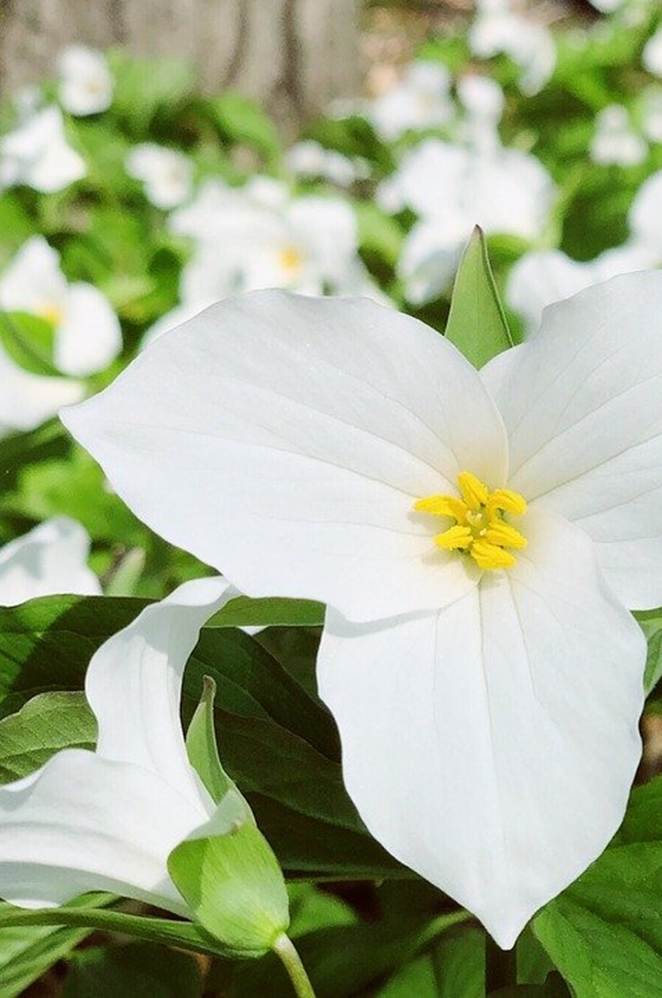


 If you catch the moment and go to the woods in the right time, you’ll be mesmerized looking at the white carpet covering everything around and usually facing the sun.
If you catch the moment and go to the woods in the right time, you’ll be mesmerized looking at the white carpet covering everything around and usually facing the sun.
No North American wildflower is more popular than the white trillium. It is easily recognized by its beautiful large three-petal white flowers, which usually bend toward the sun as it moves across the sky. They quickly bloom when big trees are still “naked”. Botanically, they are “spring ephemerals.”
White trillium, Trillium grandiflorum, is a perennial that grows from a short rhizome and produces a single, showy white flower atop a whorl of three leaves. The erect, odourless flowers are large, with 4 to 7 cm long petals, depending on age and vigour. The petals are shaped much like the leaves and curve outward.
In nature, trilliums grow very slow. Trillium Grandiflorum typically requires 7-10 years in optimal conditions to reach flowering size.
Trilliums are extremely fragile: if you pick the flower no other trillium will grow in its place, even if the rhizome is left undisturbed.
Depending on geographical factors, it flowers from late April to early June.
As a particularly conspicuous forest flower, white trillium was designated the provincial floral emblem of Ontario in 1937.
2. Crocus
Crocus sativus, commonly known as saffron crocus, is a tiny stunningly beautiful flower, one of the first bulb flowers of the season.
Crocus Valley in the Carpathian Mountains, Ukraine

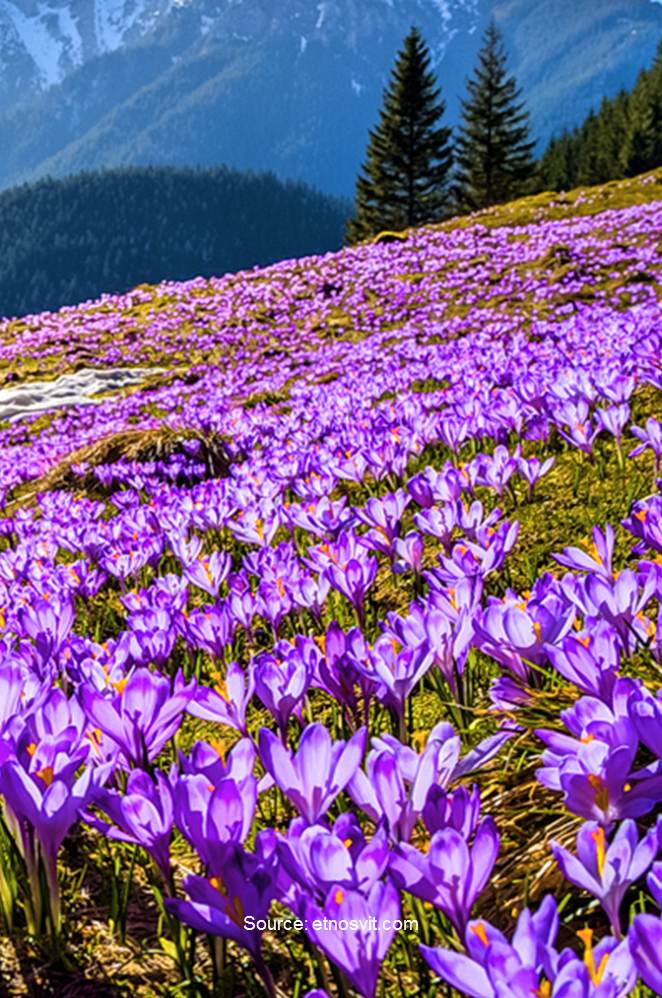



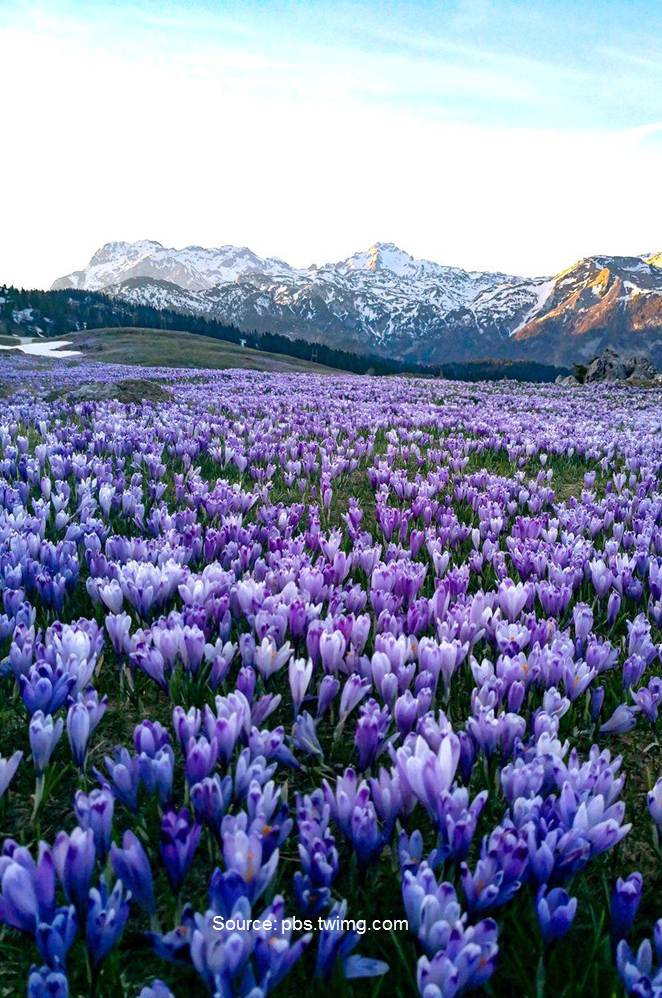 In early spring, as soon as the snow melts, the first spring flowers – crocuses – appear in the Carpathian Mountains. The amazing beauty of this natural lilac miracle can only be compared with lavender fields in France. Crocuses cover the land that has not yet woken up after winter with a purple carpet, adding bright colours to the gray palette of the environment.
In early spring, as soon as the snow melts, the first spring flowers – crocuses – appear in the Carpathian Mountains. The amazing beauty of this natural lilac miracle can only be compared with lavender fields in France. Crocuses cover the land that has not yet woken up after winter with a purple carpet, adding bright colours to the gray palette of the environment.
The most popular “crocus” destination is Kolochava village. This is a small picturesque mountain village located in the very heart of Carpathian Mountains in Ukraine. This is a very popular recreational destination, which offers fresh mountain air, breathtaking views, mineral water springs and impressively well-preserved culture and traditions of the region. Kolochava is often referred to as a museum-village. Here travelers can discover the genuine lifestyle of Carpathian ethnical groups.
Crocus in Dusseldorf, Germany
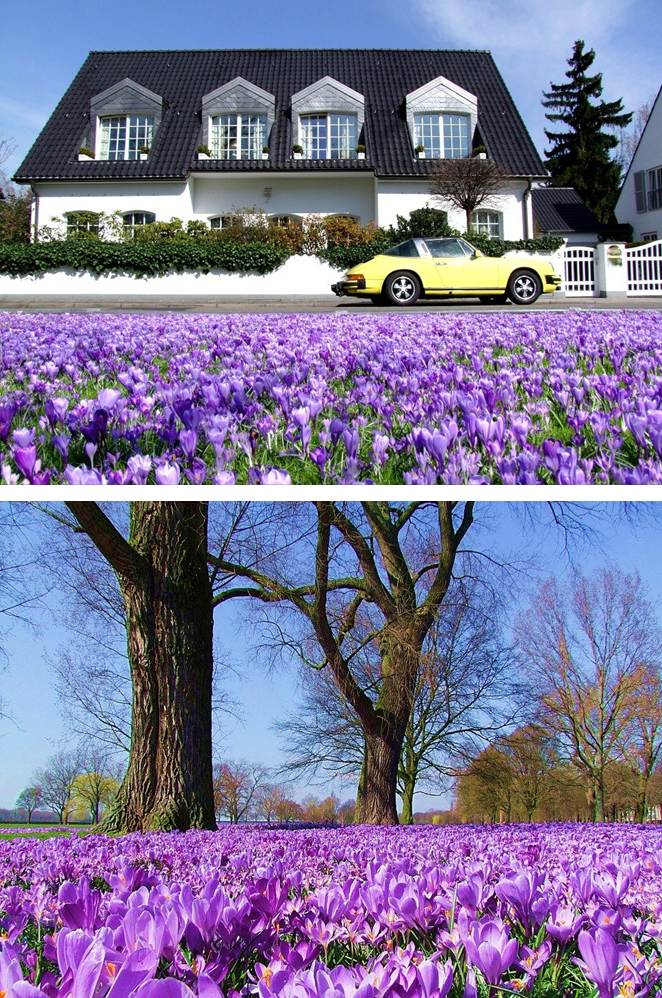

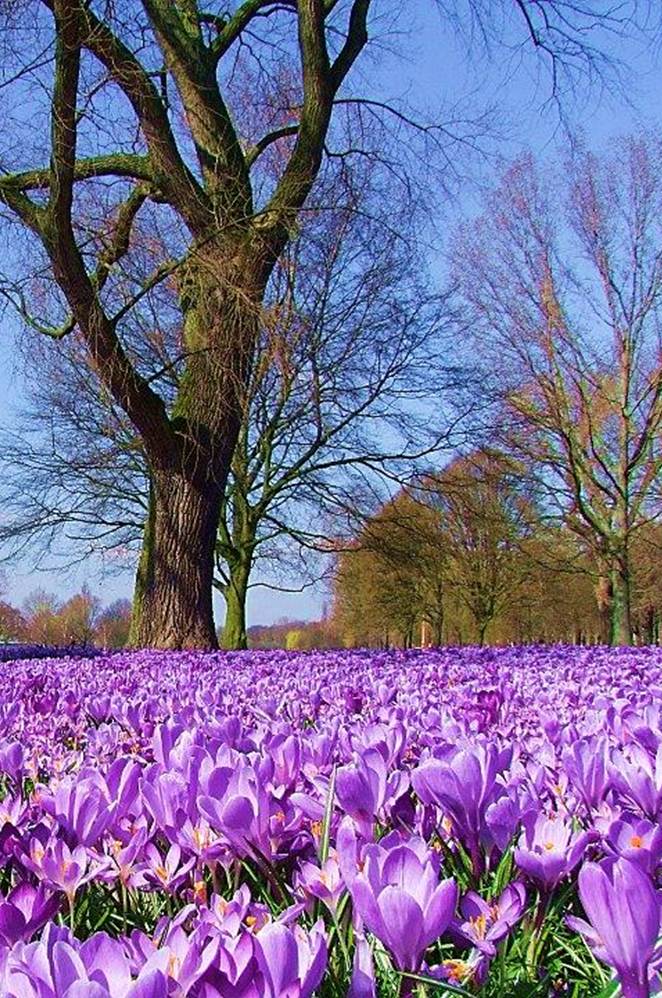 In early spring, carpets of crocuses are bursting with life and colour across the world, including the City of Dusseldorf.
In early spring, carpets of crocuses are bursting with life and colour across the world, including the City of Dusseldorf.
Saffron – the world’s most expensive spice
Saffron is derived from the dried stigmas of the purple crocus flower. At US $1,100 to $11,000 per kilo, saffron is the world’s most expensive spice. Why saffron is so expensive? Because it requires the harvest of 110,000–170,000 flowers to glean 1 kilogram of dry saffron, and 40 hours of labour are needed to pick 150,000 flowers. A pound contains between 70,000 and 200,000 threads. The flowers have to be individually hand-picked when they fully open. Stigmas are dried quickly upon extraction and have to be sealed in airtight containers.
In the 21st century, Iran produces some 90% of the world total for saffron.
Crocus in Greek mythology
In one variation of the myth, Crocus was said to be a companion of Hermes and was accidentally killed by the god in a game of discus. Crocus’ blood drops were transformed into a radiant flower.
In another variation, Crocus was a mortal youth of fine and noble spirit. One day he saw the beautiful nymph Smilax in the woods near Athens and fell deeply in love with her. Crocus set out in pursuit of Smilax and initially Smilax was flattered by his amorous advances, but soon got bored by his attentions. Because he was unhappy with his love affair, he was turned by the gods into a plant bearing his name, the crocus. Its radiant orange stigmas remain as a faint symbol of his undying passion for Smilax.
3. Narcissus Valley, Khust City, Ukraine
The largest valley of wild daffodils in Europe

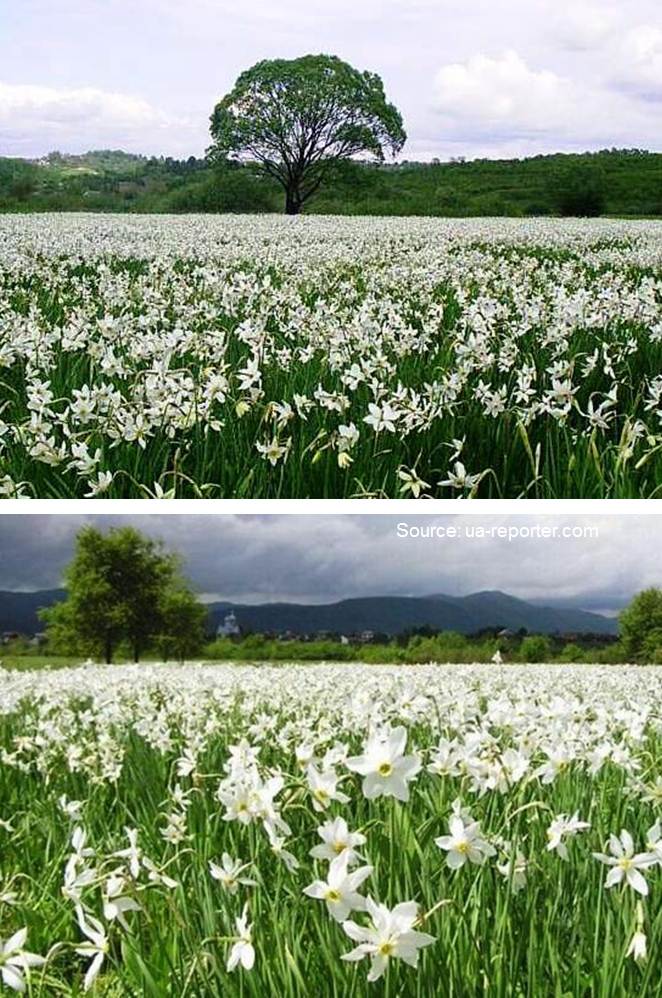



 Narcissus Valley is the Carpathian Biosphere Reserve, a unique protected area located 4 km from the town of Khust in Western Ukraine. It is the largest valley of wild daffodils in Europe. The total area of this reserve is 256 hectares, of which daffodil fields occupy 170 hectares.
Narcissus Valley is the Carpathian Biosphere Reserve, a unique protected area located 4 km from the town of Khust in Western Ukraine. It is the largest valley of wild daffodils in Europe. The total area of this reserve is 256 hectares, of which daffodil fields occupy 170 hectares.
The uniqueness of the Valley of Daffodils lies in the fact that it is not in the mountains, but on the plain, which in itself is unusual for this flower. This is the world’s largest array of natural thickets of wild narrow-leaved narcissus, a rare endangered plant. The narrow-leaved narcissuses are wild relatives of garden daffodils.
The geographical history of the Valley of Daffodils dates back to the time of the Ice Age. According to scientists, geological cataclysms occurred during the Ice Age and a huge piece of land slid from the mountains along with plants, which became endemic to this valley.
They began to protect the valley during the times of Austria-Hungary. Under the Soviet rule, the authorities wanted to plow the land, began reclamation work, but thanks to the efforts of prof. V. Komendar, the territory became the Carpathian Biosphere Reserve.
In early May, thousands of people come to the valley of daffodils to admire the massive bloom of these delicate flowers. The flowering period lasts about two weeks.
Narrow-leaved narcissus
Native to Europe, Narcissus angustifolius is a synonym for Narcissus poeticus (also known as poet’s daffodil, poet’s narcissus, nargis, pheasant’s eye, findern flower, and pinkster lily). It blooms in early spring with a strong fragrance. The petals are white and the corona is very short yellow with a thin band of red at the rim. Narcissus poeticus was one of the first daffodils to be cultivated, and is frequently identified as the narcissus of ancient times.
Legends about Narcissus
The name Narcissus comes from the Greek word for narcotic and is tied to the myth of a young man known as Narcissus who fell in love with his own reflection. Narcissus was punished by the Goddess of vengeance, Nemesis, who turned him into a Narcissus flower. When he drowned in the pool where he had been admiring himself, Narcissus flowers grew up around the pool.
The fragrant daffodil has also been recognized as the flower that Persephone and her companions were gathering when Hades abducted her into the Underworld. This myth accounts for the custom, which has lasted into modern times, of decorating graves with these flowers. Linnaeus, who gave the flower its name, quite possibly did so because he believed it was the one that inspired the tale of Narcissus, handed down by poets since ancient times.
4. Bluebells in the Hallerbos, Belgium
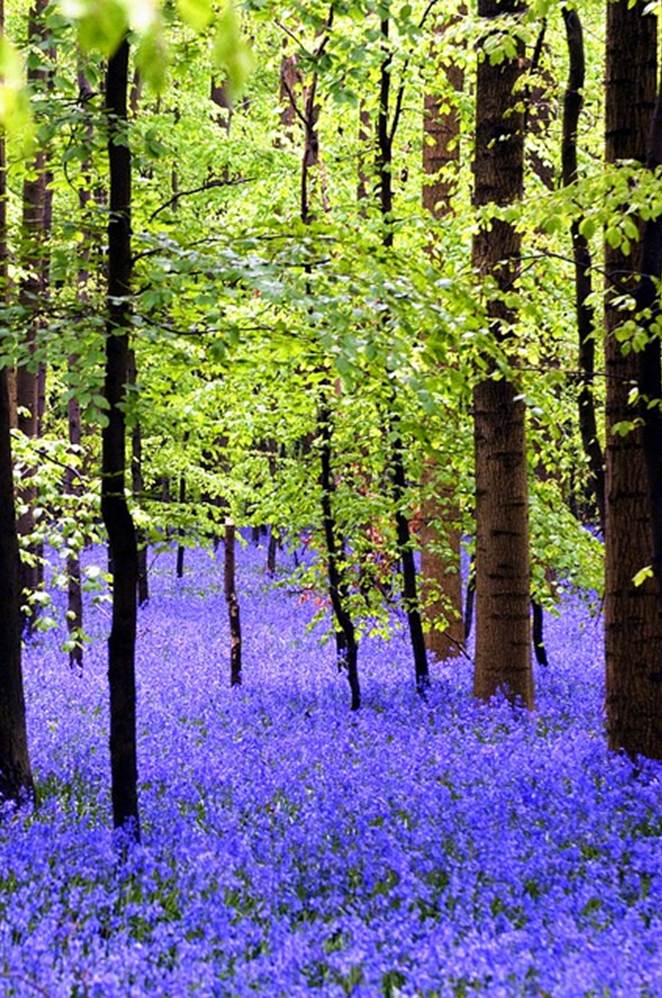
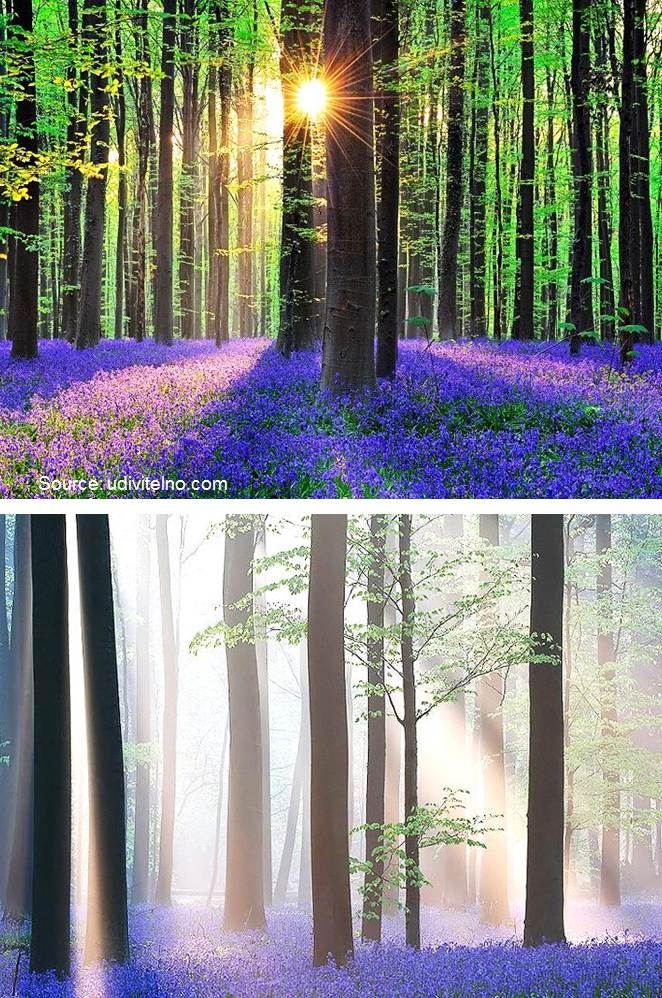



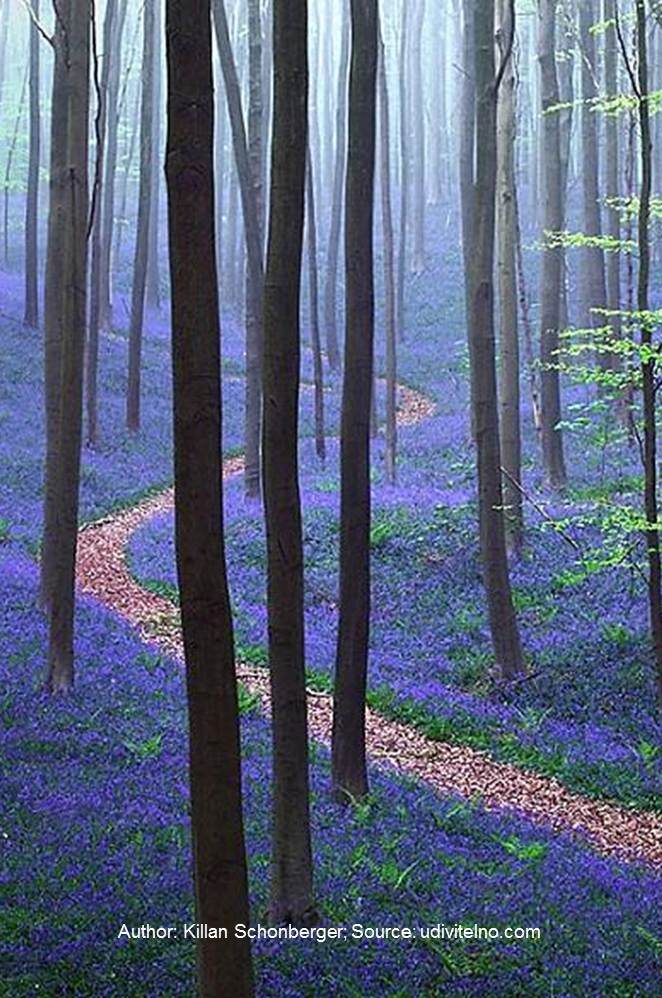
 Hallerbos – “The Blue Forest” – is a public forest administered by the local government and most extensive forest area in Belgium between Zenne and Zoniën, covering an area of 552 hectares.
Hallerbos – “The Blue Forest” – is a public forest administered by the local government and most extensive forest area in Belgium between Zenne and Zoniën, covering an area of 552 hectares.
The forest is famous for its bluebell carpet which covers the forest floor for a few weeks each spring, attracting thousands of visitors.
An ultramarine blanket extends as far as the eye can see, circling the trees, lining valleys and decorating stream banks. The purple blue of the bluebells combined with the transparent bright green of the young beech leaves give a magical effect to the forest. The sunlight still reaches the flowers through the leaf canopy, but a little less each day.
Hyacinthoides non-scripta is known in English as the common bluebell or simply bluebell. In spring, it produces a nodding, one-sided inflorescence of 5–12 tubular, sweet-scented violet-blue flowers and 3–6 long, linear leaves. Bluebell is particularly associated with ancient woodland where it may produce carpets of violet-blue flowers in “bluebell woods”.
Hallerbos is a crowd favourite thanks to the beautiful purple carpet of bluebells, which bloom around mid-April. However, the bluebells do not bloom at the same time every year, because variations in the weather influences the flowering.
5. Calla Lily Valley in Big Sur, California, USA






 Have you ever seen a ravine filled with hundreds of blooming wild white calla lilies? The Calla Lily valley at Garrapata state park in Big Sur is a hidden gem on the central California coast.
Have you ever seen a ravine filled with hundreds of blooming wild white calla lilies? The Calla Lily valley at Garrapata state park in Big Sur is a hidden gem on the central California coast.
The Calla Lily Valley season may start as early as the end of January. The blooming swells by mid-February and continues through mid-April and sometimes all way through the month. During the season, the view of a little valley along Highway 1 with thousands of naturally thriving beautiful flowers is just breathtaking.
At first glance it may feel like you are simply walking towards overgrown shrubs, but suddenly the valley opens up and you are greeted to Doud Creek, the beautiful Calla Lilies, and the Garrapata State Beach in the distance.
There is no main entrance to the park. Visitors can park in several pullouts along Big Sur Coast Highway
6. Rhododendron
Found in varied habitats from subtropical forest to alpine shrubs, rhododendrons range from dwarf shrubs to large trees. Rhododendron is a very large genus of 1,024 species of woody plants in the heath family, Ericaceae, either evergreen or deciduous, and found mainly in Asia, although it is also widespread throughout the world. Most species have brightly coloured flowers which bloom from late winter through to early summer.
Rhododendron in the Carpathian Mountains, Ukraine




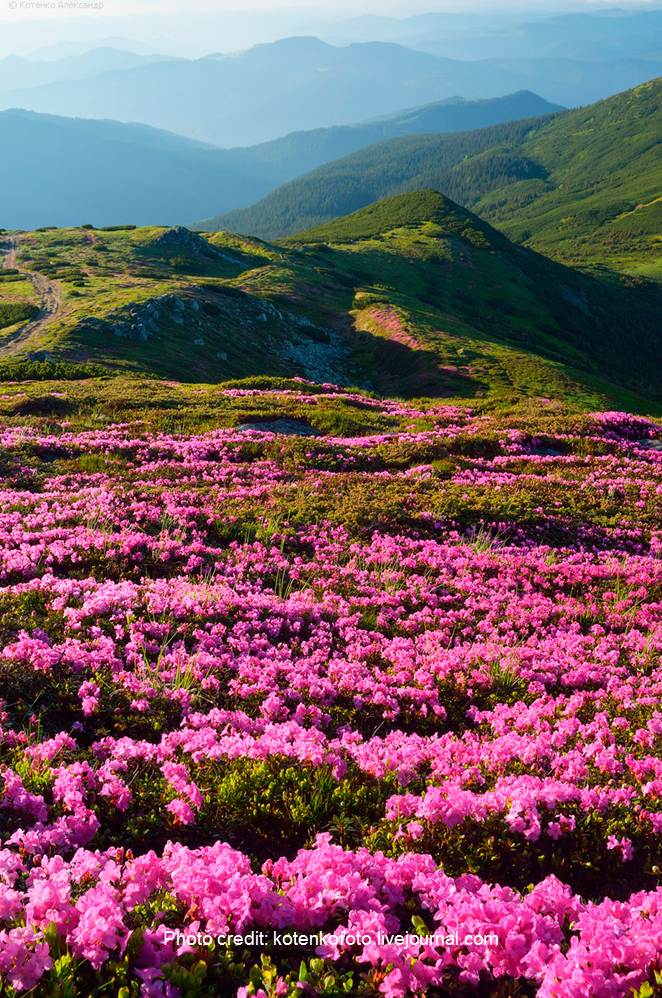 In early June, blossoming rhododendron covers the mountains with the bright laces of deep violet-lilac flowers. It’s time to plan a trip to enjoy the incredible beauty and a delicate aroma. You can see flowering only in the mountains. Rhododendron does not grow on plains. Maybe that’s why magical properties are attributed to the flower, calling the rue witchcraft.
In early June, blossoming rhododendron covers the mountains with the bright laces of deep violet-lilac flowers. It’s time to plan a trip to enjoy the incredible beauty and a delicate aroma. You can see flowering only in the mountains. Rhododendron does not grow on plains. Maybe that’s why magical properties are attributed to the flower, calling the rue witchcraft.
Being the only native rhododendron in Ukraine, Rhododendron myrtifolium (also R. kochi) can be found growing in compact groups on the northern and southern slopes (1500-1600 m above sea level) of Chornohora, the highest range of the Eastern Carpathian Mountains, on Petros and Hoverla (2062 m) peaks in the West, to the peak of Pip Ivan Chornohorski in the East.
Rhododendron in the Altai Mountains, Russia
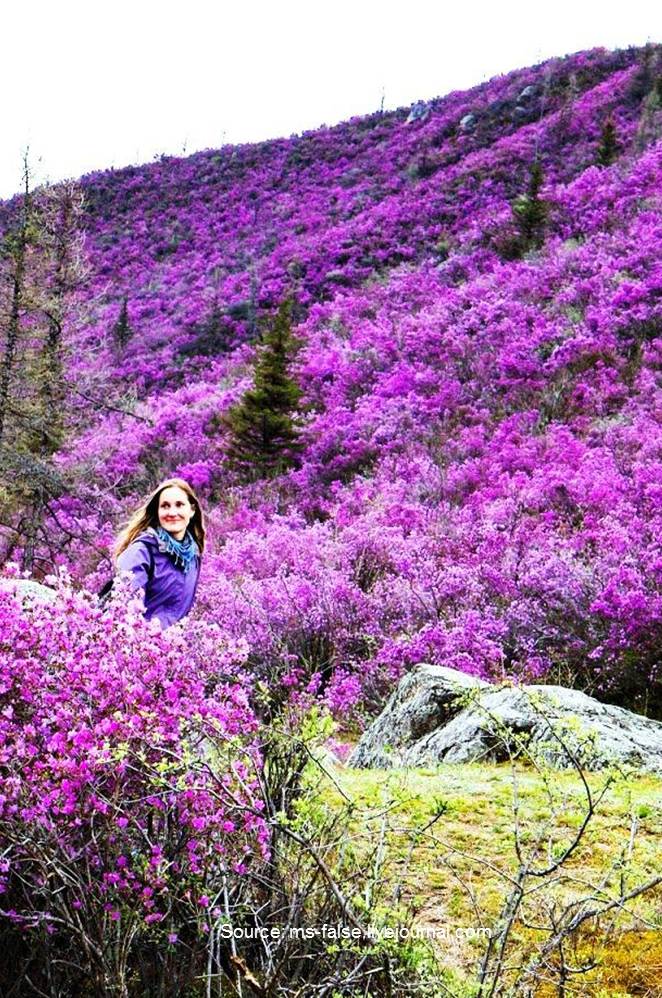



“Siberian cherry”, Rhododendron ledebourii (locals call it maralnik or bagulnik) attracts lots of people to enjoy the massive blooms of the beautiful flowers. Often, maralnik blooms when the snow has not melted yet.
This rhododendron grows naturally in Russia’s Altai Mountains. It is particularly hardy and can be grown in a wide variety of places. In May, when the slopes are covered with dense undergrowth, a carpet of lilac flowers of maralnik becomes the main attraction of the Altai Mountains.
The small herb-scented oval leaves remain on the shrub through part of the winter, changing to a dark red-brown. Early in spring violet-red flowers appear at the ends of the shoots; individual blossoms may be 2-4 cm, with 3-8 in a cluster. In the wild the species survives as a creeping sub-shrub among lime-rich rocks or may even grow to about 2 m on moist peat in birch and mixed forest.
In winter, maralnik, semi-evergreen shrub, “twists” the leaves, because of what they are like pine needles. If in February you put twigs into the water, after two or three weeks they will have the first flowers. Sometimes the plant can re-bloom in late summer or early fall.
Maralnik is toxic, and this explains why it is not eaten by a goat, cow or wild animals. Poisonous can be even honey collected from flowers of maralnik.
The Ukok Plateau
Snowy mountain peaks, bright Rhododendron ledebourii flowers, barrows and mountain lakes – all this forms a natural ensemble of indescribable beauty. The Ukok Plateau can rightfully be called one of the most remote and mystical places on the map of the Russian Federation. It is located almost in the center of the Eurasian continent, at the junction of the borders of Kazakhstan, Russia, Mongolia and China. It’s a unique place in the world that is included in the UNESCO heritage list. The Ukok Plateau is often compared to Tibet or Machu Picchu by the power of sensations.
7. Lycoris on the Kinchakuda Plateau, Hidaka City, Japan

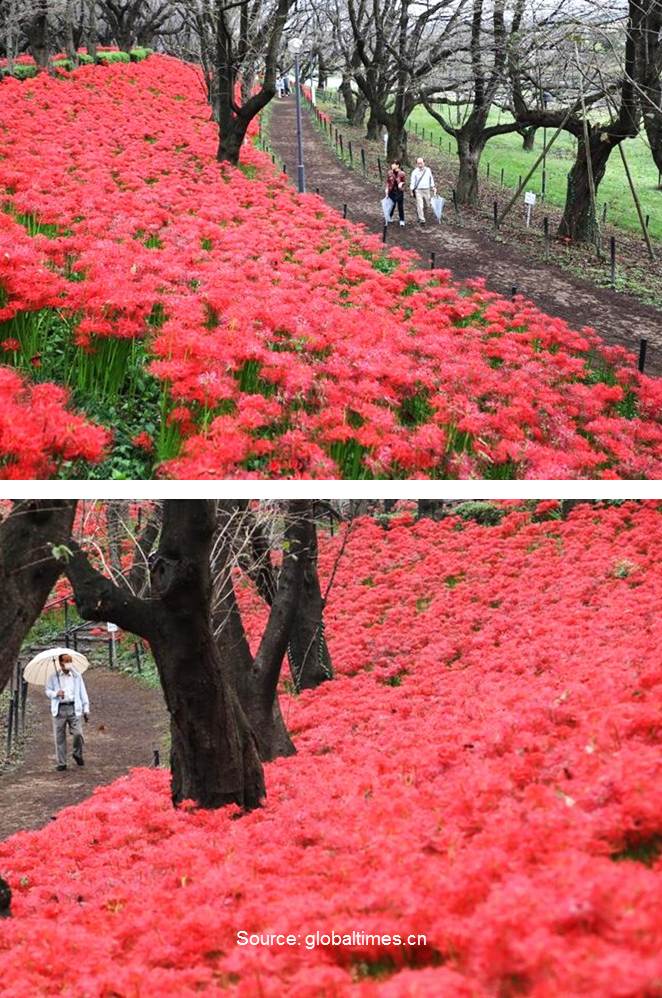
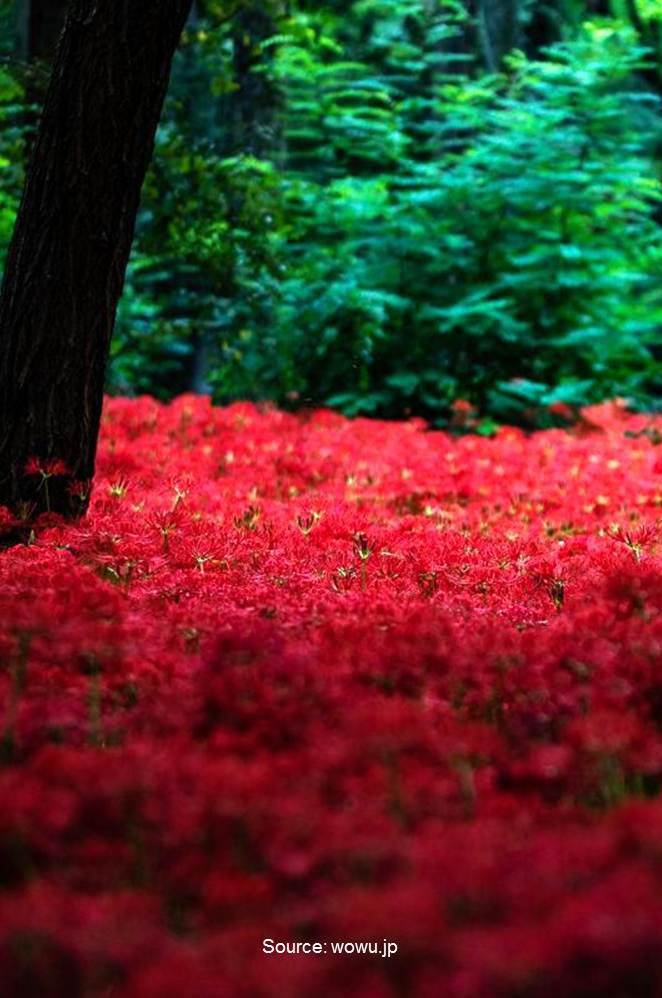


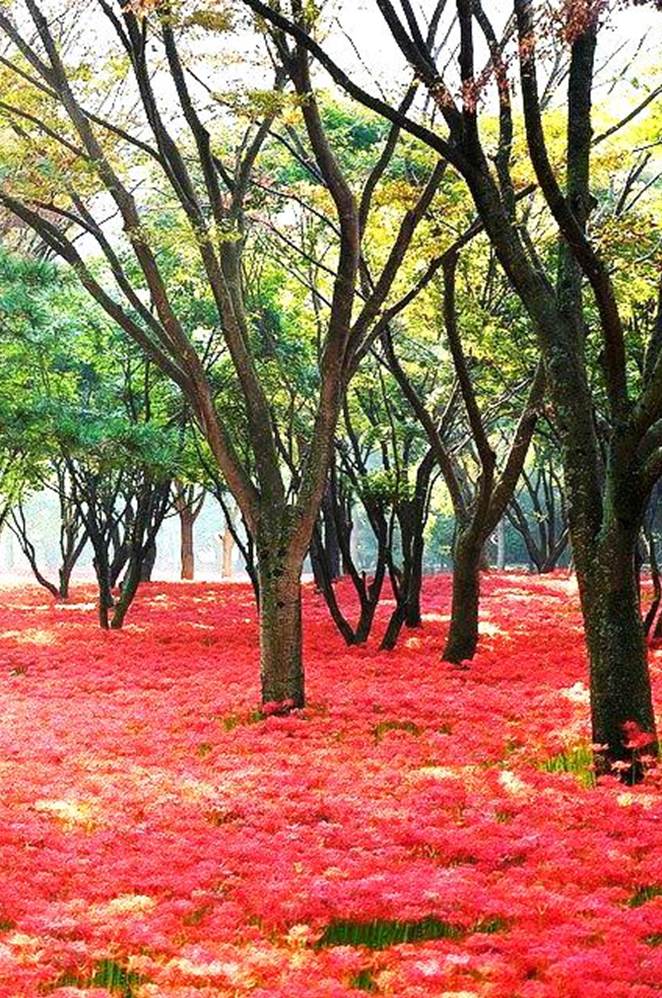
 Lycoris radiata, known as the red spider lily, red magic lily, or equinox flower, is a plant in the amaryllis family, Amaryllidaceae.
Lycoris radiata, known as the red spider lily, red magic lily, or equinox flower, is a plant in the amaryllis family, Amaryllidaceae.
In Japan the red spider lily signals the arrival of fall. Lycoris blooms in late summer or early fall, with stems around 61–71 cm tall. Leaves follow the flowers, remaining through the winter and disappearing in early summer. The flowers fade over the course of a week from brilliant fluorescent red to a deep pink.
In September, 5 million red spider lilies blossom in full glory in Kinchakuda Manjushage Koen Park in Hidaka City. The entire area turns ruby red, and it looks as if it had been spread with a red carpet.
Since these scarlet flowers usually bloom near cemeteries around the autumnal equinox, they are described in Chinese and Japanese translations of the Lotus Sutra as ominous flowers that grow in hell and guide the dead into the next reincarnation.
Many Buddhists will use it to celebrate the arrival of fall with a ceremony at the tomb of one of their ancestors. They plant them on graves because it shows a tribute to the dead. People believe that since the red spider lily is mostly associated with death, one should never give a bouquet of these flowers
Perhaps because of these sorrowful legends, Japanese people often used these flowers in funerals.
8. Lupine
Is lupine flower a beauty or a beast?
Lupine in Eastern Iceland

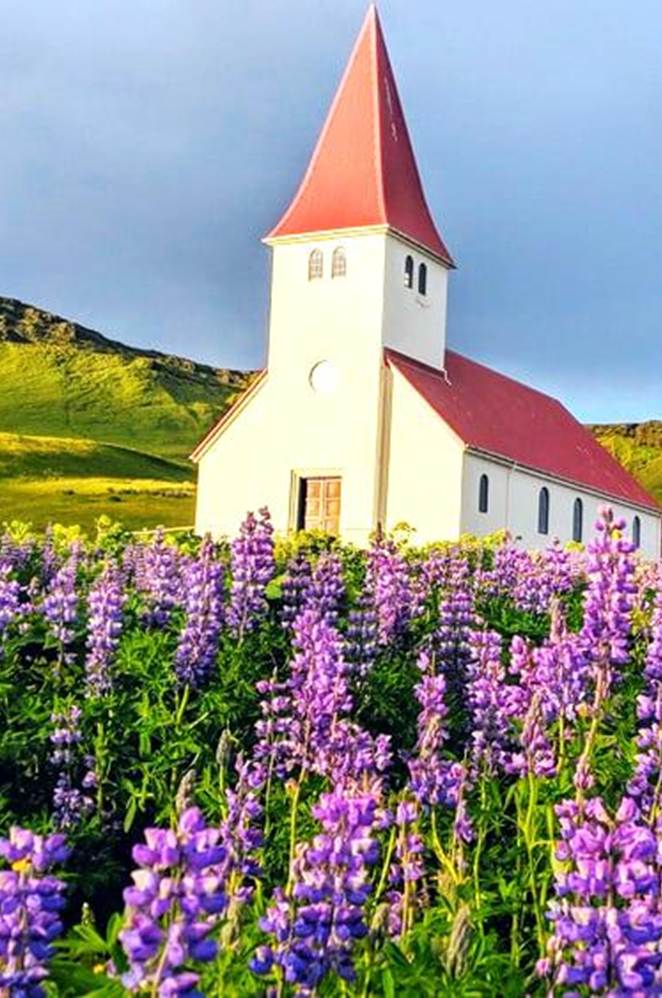

 Since its introduction in the 1970s to control soil erosion, lupine has spread wildly in Eastern Iceland. Large fields of purplish-blue plants stretch high up the mountains.
Since its introduction in the 1970s to control soil erosion, lupine has spread wildly in Eastern Iceland. Large fields of purplish-blue plants stretch high up the mountains.
To tourists and plenty of Icelanders the lupine fields are a breathtakingly beautiful sight in midsummer, the attractive blossoms carpeting gorges, sprawling over lava fields and climbing steep mountainsides. But for some natives, the plants are an alien blot on the landscape that needs to be eliminated.
Lupine in New Zealand





 In New Zealand, where it is known as the Russell lupine, Lupinus polyphyllus has escaped into the wild and classed as an invasive species. It grows in big numbers and covers large areas next to roadsides, pastures, riverbeds and streams, especially on the South Island. It is documented as being first naturalized in 1958 and it has been suggested that tour bus drivers deliberately spread seeds of the plant to promote colourful roadside vegetation in areas which some tourists may consider to be rather drab.
In New Zealand, where it is known as the Russell lupine, Lupinus polyphyllus has escaped into the wild and classed as an invasive species. It grows in big numbers and covers large areas next to roadsides, pastures, riverbeds and streams, especially on the South Island. It is documented as being first naturalized in 1958 and it has been suggested that tour bus drivers deliberately spread seeds of the plant to promote colourful roadside vegetation in areas which some tourists may consider to be rather drab.
The Russell lupine is a perennial herbaceous plant with stout stems growing to 1.5 metres tall. The polyphyllus variety in particular make up a great number of the hybrids which can vary dramatically in colours.
It’s very sad that in New Zealand’s South Island lupines are a severe environmental threat, because the view of the sea of flowers is just amazingly beautiful.
9. Golden poppy in California, USA

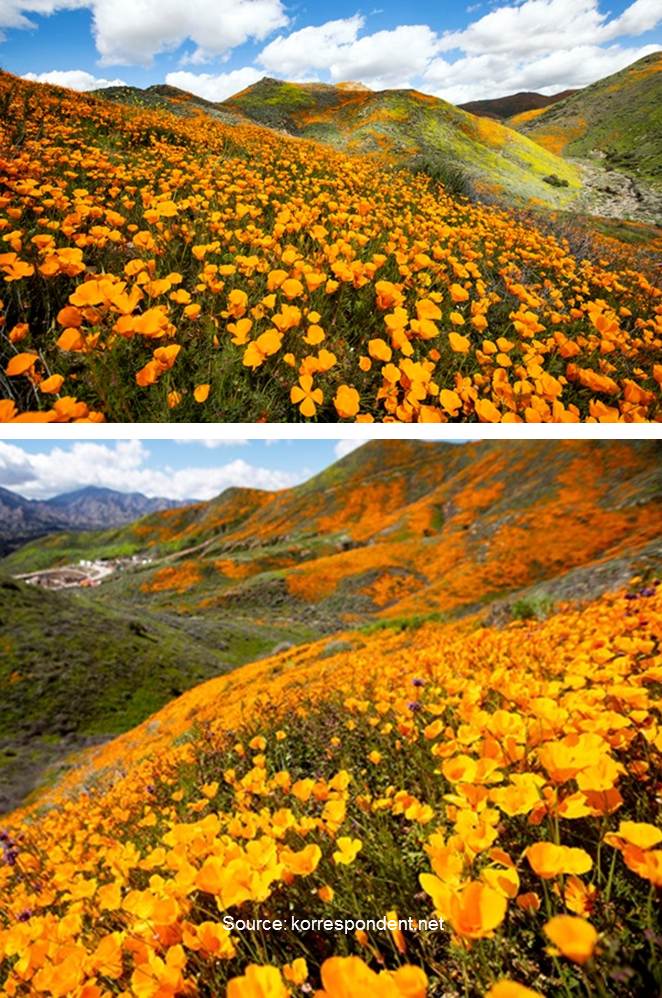
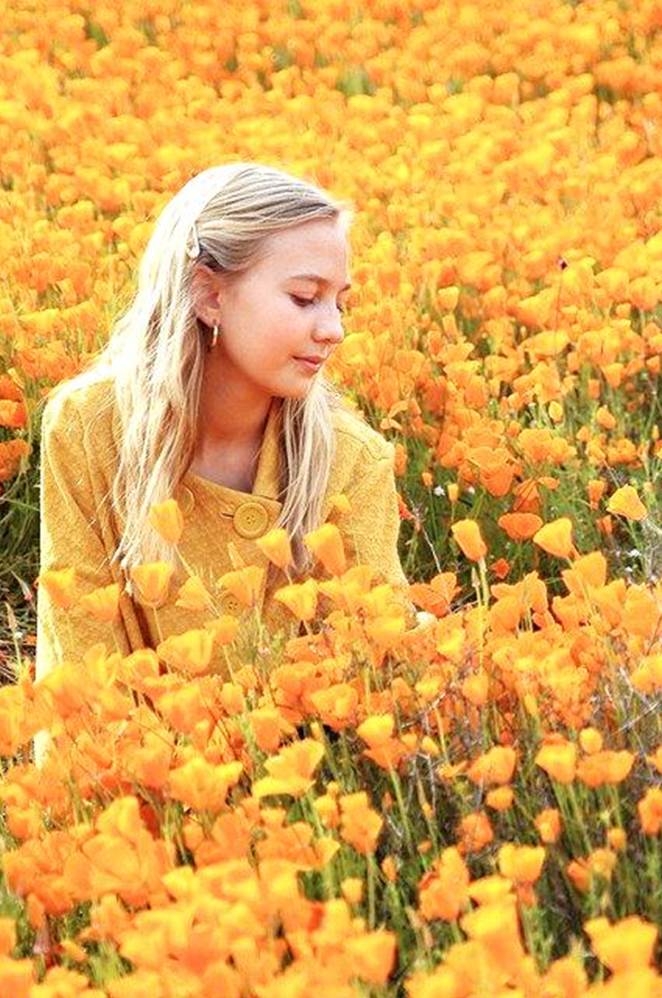
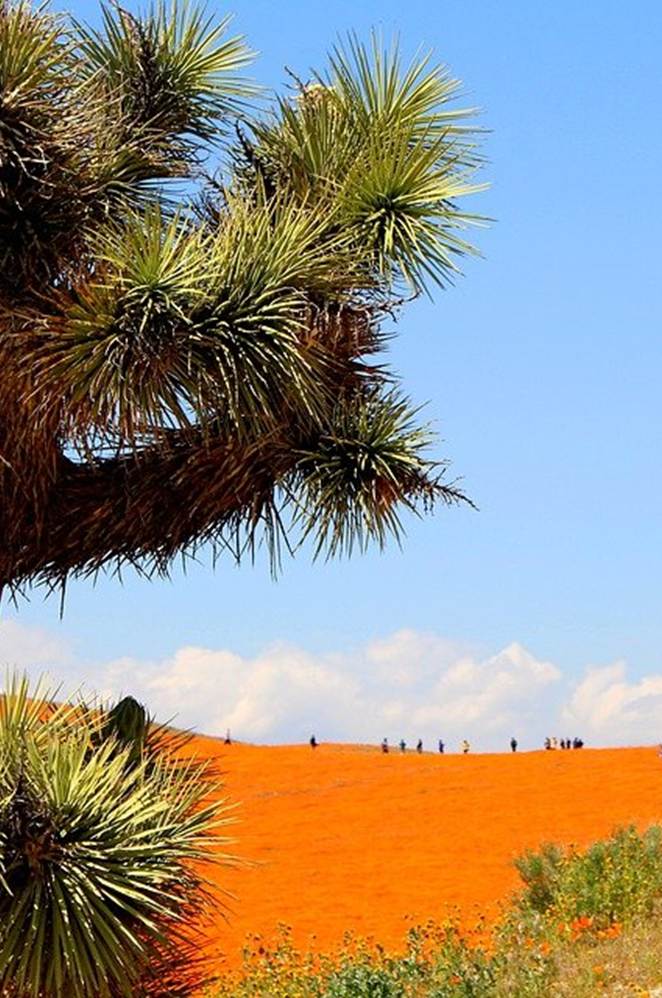

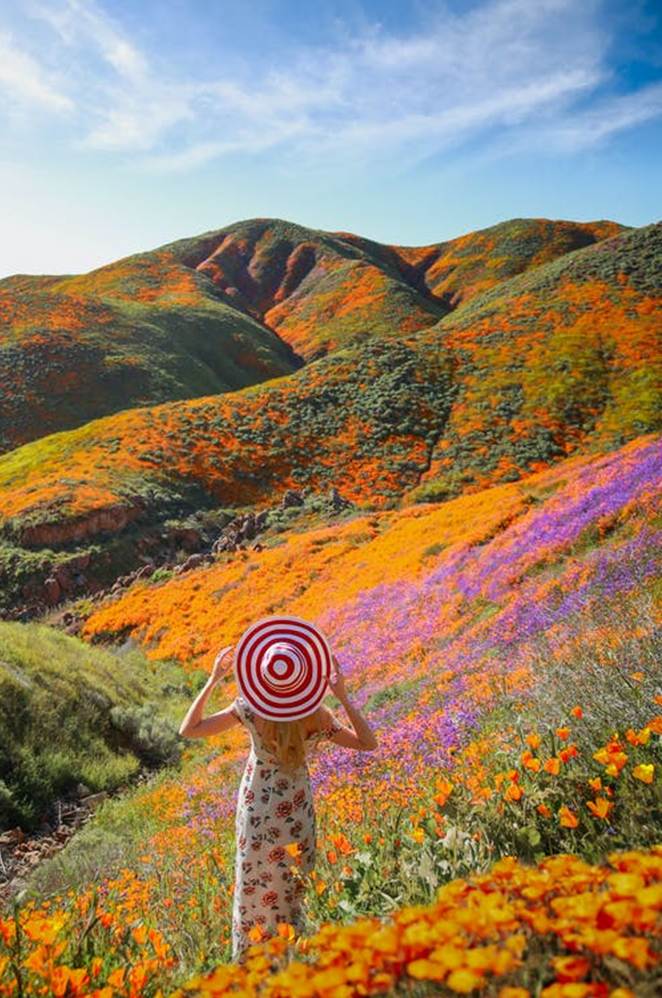
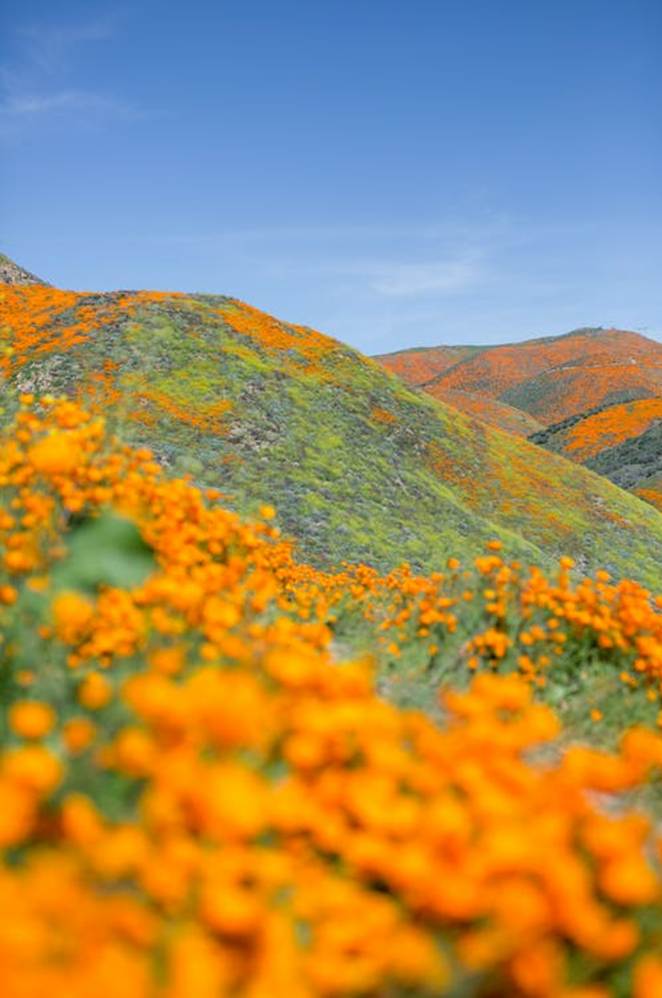

 California’s golden carpet of blooming poppies beckons travelers and especially stunning selfie hunters. This super bloom in California is even more valuable because it does not happen every year. For the appearance of this exuberant beauty, several conditions must develop: warm winters and heavy rains. Thousands and thousands of people visit the blooming mountains. The stream of tourists armed with cameras usually is so powerful that the authorities have to block the road to parks and canyons. Sometimes, people even faint from the strong scent of flowers like Dorothy in the magical Land of Oz.
California’s golden carpet of blooming poppies beckons travelers and especially stunning selfie hunters. This super bloom in California is even more valuable because it does not happen every year. For the appearance of this exuberant beauty, several conditions must develop: warm winters and heavy rains. Thousands and thousands of people visit the blooming mountains. The stream of tourists armed with cameras usually is so powerful that the authorities have to block the road to parks and canyons. Sometimes, people even faint from the strong scent of flowers like Dorothy in the magical Land of Oz.
Eschscholzia californica, the California poppy, golden poppy, California sunlight or cup of gold, belongs to the family Papaveraceae, native to the United States and Mexico. It is cultivated as an ornamental plant flowering in summer, with showy cup-shaped flowers in brilliant shades of red, orange and yellow (occasionally pink). It became the official state flower of California in 1903.
The Antelope Valley California Poppy Reserve is located in northern Los Angeles County. At the peak of the blooming season, orange flowers seem to cover all 1,745 acres (706 ha) of the reserve. Other prominent locations of California poppy meadows include Bear Valley (Colusa County) and Point Buchon (San Luis Obispo County).
10. Snowdrops in Welford Park, Newbury, UK


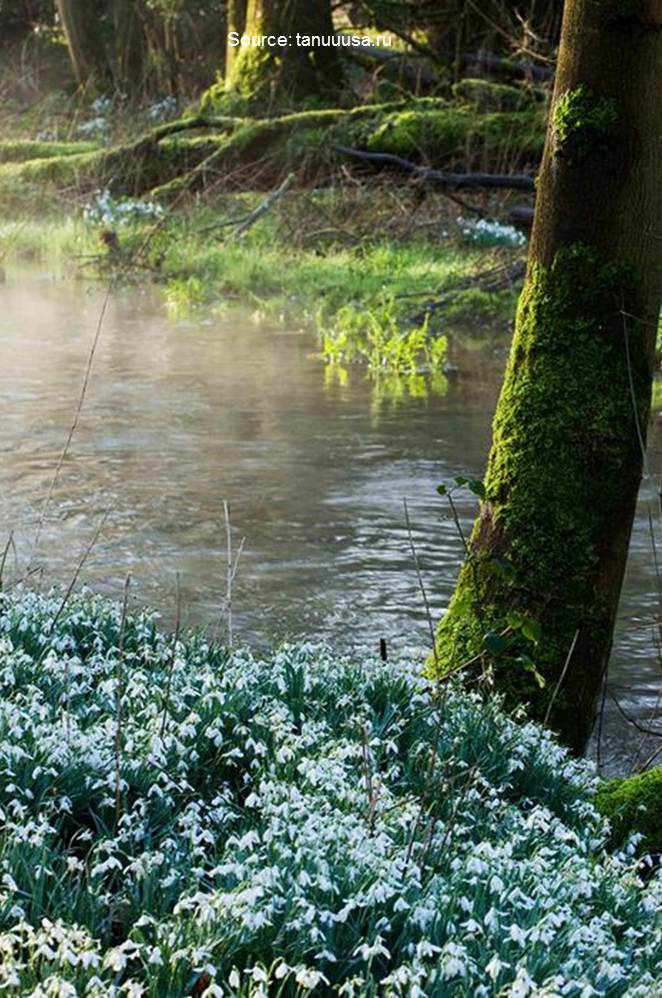

 It’s wonderfully written on the Welford Park website:
It’s wonderfully written on the Welford Park website:
“Living in the village of Welford at the heart of the Lambourn Valley you cannot escape the annual anticipation of the first snowdrop bloom. This can be as early as Christmas, and some years not until mid-January. But they are a reliable, hardy little flower which take no notice of world affairs but pop up their tiny pure white heads to say ‘Hello, spring is coming’, with a naivety that only nature can offer. … You can’t fail to gaze in wonderment, feel better and have your spirits lifted by this extraordinary sight”.
Welford Park is a country house and estate in the village of Welford in the English county of Berkshire, situated 5.2 miles northwest of Newbury. The present house was originally built in 1652.
The estate opens its grounds to the public every year for about four weeks to enable visitors to see the carpets of snowdrops that line the riverbanks and flow through the nearby woods.
Welford Park is a private residence, and for most of the year neither it nor its grounds are open to the public. However, in a tradition that is now over 50 years old, the grounds are opened to enable visitors to view the year’s bloom of snowdrops and, to a lesser extent, aconites. The flowers thrive on the chalky soil, forming a white carpet across the estate’s riverside beech woodland.
The actual dates of opening vary from year to year, depending on the state of the blooms. In recent years, the park has been opened for about four weeks in late winter from Wednesdays to Sundays. As one of the first signs of the end of winter, Welford’s snowdrops are generally well covered by the local, and sometimes national, press, and attract large crowds of visitors. Car parking is free of charge at a nearby car park, although there is a fee for admission to the grounds.
Kochia and Nemophila in Hitachi Seaside Park, Hitachinaka, Japan
Located in the area facing the Pacific Ocean in the city of Hitachinaka, Hitachi Seaside Park is a flower paradise – flowers as far as the eye can see. Hitachi Seaside Park, a Japanese national park, is one of the top sightseeing gems in eastern Japan, north of Tokyo. The vast park stretches over roughly 200 hectares and is divided into seven areas.
Hitachi Seaside Park features fantastic blooming flowers around the year but it has become world-known for its baby-blue-eyes flowers – nemophila. In addition to the annual “Nemophila Harmony”, the park features a million daffodils, 170 varieties of tulips, and many other flowers. The park includes cycling trails and a small amusement park with a Ferris wheel that sits 100m above the sea level and offers breathtaking views.
11. Kochia in Hitachi Seaside Park




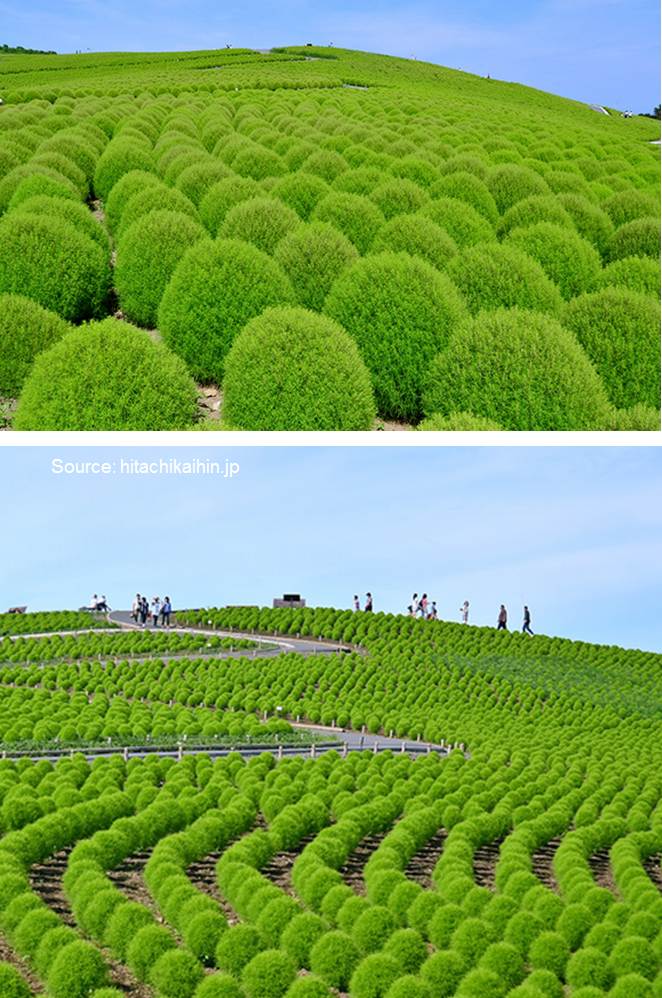

 What is kochia?
What is kochia?
Bassia scoparia is a large annual herb in the family Amaranthaceae native to Eurasia. Its common names include burningbush, ragweed, summer cypress, mock-cypress, kochia, belvedere, Mexican firebrush, and Mexican fireweed.
Kochia is a plant of a cute fluffy round shape that is soft to the touch. If you look at it from afar, it looks like a massive moss ball. Its Japanese name is Houkigusa (broom bush). As the name shows, back in the old days, people made brooms from kochia.
In Japanese, kochia are known as ‘hokigusa’, meaning a plant for making brooms after drying. Kochia also produce edible nuts known as ‘tonburi’, a speciality of Akita Prefecture. Tonburi is also known as ‘the caviar of the field’ thanks to its similar shape, colour and texture. The kochia in Hitachi Seaside Park are for decorative purposes only and do not produce any edible products.
Kochia in autumn
As kochia grow, their colour changes from vibrant green in the summer to a greenish-red and finally to a bright scarlet in October. Kochia bushes are known for their unique round shape and fluffy texture. Kochia were first planted in Hitachi Seaside Park so that visitors could enjoy the vibrant fall colours as most trees in the park are evergreen pines.
The kochia’s slow transition from green to red looks like a work of art. As the season begins to settle deeper into autumn, the scenery shifts to a radiant maroon colour that envelops a huge area.
12. Nemophila in Hitachi Seaside Park, Japan
Nemophila is commonly known as Baby Blue Eyes. It is said that newborn babies of European heritage usually have blue eyes, no matter what colour they will later become.





 As the name suggests, Nemophila is a transparent round-shaped flower with a sky-blue colour, just as bright and pure like the colour of a baby’s eyes. This colour is found comparatively rare in the vegetal world, and this may be the reason why it receives so much attention.
As the name suggests, Nemophila is a transparent round-shaped flower with a sky-blue colour, just as bright and pure like the colour of a baby’s eyes. This colour is found comparatively rare in the vegetal world, and this may be the reason why it receives so much attention.
Boraginaceae family nemophila genus
Known as Rurikarakusa in Japanese, nemophila is an annual herb native to North America. The plant grows up to 20cm tall and produces flowers between 2 and 3cm in size. The small flowers mean nemophila usually plays a supporting role in gardens but at Hitachi Seaside Park the sheer number of flowers creates an almost never-ending sea of blue that flows seamlessly into the blue Spring skies.
The nemophila season
The nemophila season goes from late April to mid-May. The park is covered in a spectacular blue trio – the blue sky, blue sea and 5,300,000 blue nemophilas, which forms the unparalleled, jaw-dropping scenery that you cannot see anywhere else.
In recent years, the beautiful sights in this park have become a trend around the globe and many visitors gather here during Golden Week (the long holiday period which lasts from the end of April to the beginning of May in Japan) to get the first glimpse of the nemophila fields.



















